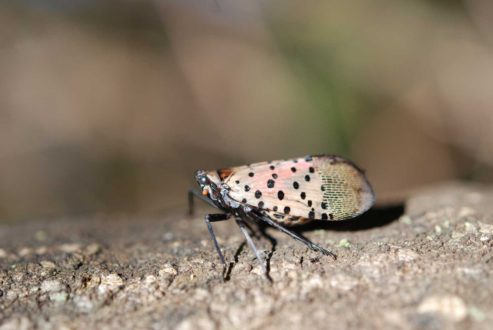Oct 29, 2021Washington state on guard after possible spotted lanternfly find
Washington State Department of Agriculture is asking the public to keep a watch for spotted lanternfly (Lycorma delicatula), a potentially destructive pest that may have been observed in the Omak region.
Spotted lanternfly (SLF), a native to Asia, attacks primarily grapes, but also has been sighted in other crops such as hops, apples, peach, and other fruit trees. Should it become established in Washington, spotted lanternfly could threaten many Washington iconic crops and result in costly quarantines and increased pesticide use to manage the pest.
In mid-October, the Washington Invasive Species Council (WISC) received a possible sighting of the pest in the Omak area and informed the Washington State Department of Agriculture (WSDA) and the U.S. Department of Agriculture. The possible sighting included a photograph and also mentioned seeing five live specimens. Despite a search of the area, WSDA entomologists could not confirm the report. WSDA is asking the public, especially those in Okanogan County, to examine their trees and other outdoor surfaces for spotted lanternfly adults and egg masses.
“Our search revealed abundant host material in the area,” Sven Spichiger, WSDA managing entomologist said in an alert. “For the next several weeks, we ask people to look for both adults and egg masses. If they think they found any suspected life stage of the pest, they should report it.”
The unconfirmed report comes during a month when WISC, WSDA, and other state agencies have been requesting that the public report tree-of-heaven locations as part of an effort to proactively locate and remove this preferred host of the spotted lanternfly. The outreach also encouraged the public to look for and report possible SLF sightings, although SLF populations are not known to be in the state at this time. SLF poses no threat to human or animal health.
“This is another example of the important role everyone plays in stopping invasive species,” said Justin Bush, the council’s executive coordinator. “If you spot a suspected invasive species, immediately notify the council through our website or phone app called Washington Invasives. You may be reporting a new invasive species and help prevent millions, if not billions, of dollars in damage and loss.”
Although the unconfirmed report does not indicate that an SLF population exists in Washington at this time, WSDA plans to survey the area for the pest in 2022. Because it is too late to survey this year, public aid in looking for and reporting possible sightings now could provide critical information about the pest’s whereabouts. A rapid response is required to successfully eradicate SLF if a population exists.
When reporting possible SLF sightings, include a photograph, date, and location of the sighting and most importantly – collect the specimens. Reports can be made using WISC’s online reporting form or mobile app or by emailing WSDA at [email protected] or calling 1-800-443-6684. After reporting, suspect specimens and egg masses can be taken to WSU Extension offices. More information about spotted lanternfly can be found on WSDA’s website. Report tree-of-heaven locations to WISC.
Spotted lanternfly first arrived in the U.S. in 2014 in Pennsylvania. Since then, it has been spreading through several eastern states while popping up in other places throughout the country. When established in an area, it can cause potential problems for growers as well as homeowners.
An adult spotted lanternfly. Photo: Pennsylvania Department of Agriculture















